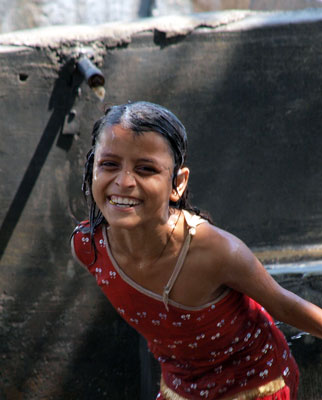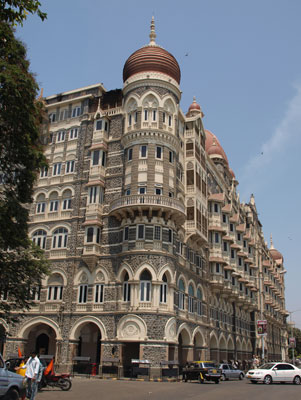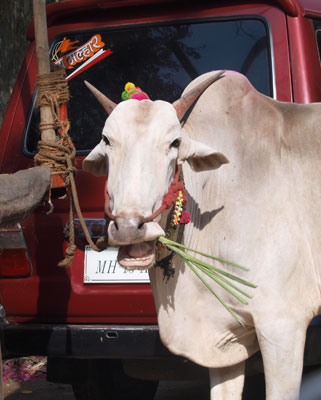Into the wilds of Mumbai
by Donna Judd, Fullerton, CA
On March 28, 2009, I stepped off the cruise ship, alone, into the exotic chaos that is Mumbai — nearly 17 million strong — for a memorable travel experience, my first in India. This was the termination point of my cruise from Mauritius, and I hoped to meet Mr. Santosh Sharma, with whom I’d developed a recent e-mail friendship through an international photography group.
After a few sweltering minutes spent ignoring a beggar and aggressive taxi drivers, I met Santosh’s friend, Mr. Shalar, who arrived with a car and driver. He was very kind, but the non-air-conditioned car was a sauna, the driver spoke no English, and Mr. Shalar knew little about tourist sites. Hmmm…
Jumping in
Santosh was stuck in traffic, so Mr. Shalar and I headed to the Gateway of India landmark. There I tried to get a young man taking a picture of his family to join them, stating that I would take their photo together. Strangely, he seemed upset with me.
A smiling guide came over and explained that the man was a professional photographer taking photos for Indian tourists. Savrav (phone 09 8191 36153) spoke perfect English and was very knowledgeable, so I hired him to guide us.
We walked around the Gateway, then saw the nearby Taj Mahal Palace Hotel, one of the sites of the November ’08 terrorist attacks, and Marine Drive with its beautiful bay.
I finally met up with Santosh and we enjoyed a brief visit before he had to leave. Then I was off to explore nontouristy Mumbai with three men I’d only just met. Mom would not have approved.
An intimate look
First, my pick-up guide called a friend who lived in a shantytown and he agreed to guide us through his “Slumdog Millionaire”-like area. Savrav held onto my hand as we squeezed through narrow walkways, peeking into people’s tiny, one-room “apartments.”
One man, sitting on a bare floor with some rice in a bowl, asked me to join him for lunch. His home was the size of my kitchen island at home, with no bed, chair or table, only a small refrigerator.
People were friendly and seemingly not resentful of my presence. I was followed everywhere by little kids, whom Savrav gave candy as we were leaving. When I commented that no one was begging, his friend said, “They are poor, but they are not beggars. Most are working, in some form.”
When we exited, 20 to 30 people were jostling to fill up jugs with water, excited because water was not often available that late in the morning. No water or sanitation was available in the homes, and “many fights occur when the water is running out.”
Children of shantytowns are not eligible to go to school. I saw a little girl standing on top of a large bin digging through trash. People were welcoming, but the poverty was tough to take.
Snapshot impressions
Next we went to Dhobi Ghat, the open-air laundry where clothes from homes and hotels are washed by hand in individual concrete stalls.
I saw a man getting a shave while others slept, all among the laundry which was hanging up or lying on rooftops to dry. I was touched especially by one skinny man who shook with excitement when I took his photo. We smiled and waved for a long time; he seemed to have such a positive outlook on life.
Needing a break, I went to the Leopold Café (Colaba Causeway) for some great tandoori chicken and naan. I was fortunate to be seated with an Indian man who had lived in Europe and spoke perfect English. He pointed out a large mirror nearby, still shattered by bullets from the terrorist attack.
Next I visited the touching Gandhi Museum, and we stopped at the beach for a view of the 15th-century Haj Ali Dargah mosque, situated out on an island, shimmering in silver water. Then we stopped in a small harbor where fishing boats were flying colorful flags in honor of the Hindu New Year being celebrated that day.
Rush of emotions
The 100-degree heat and the humidity were really starting to affect me, so I returned to the port gate, greatly touched by the kindnesses of Santosh, who spent 2½ hours in traffic to come see me when he was supposed to be off with his parents, who were visiting from his hometown; Mr. Shalar, the car owner, who invited me to his home to have some of the sweets his wife had made for the holiday, and Savrav, who kindly held my hand at every street crossing and stairway.
At the port, and miles from where I had hired him, I tried to pay Savrav 1,000 rupees, but he said, “That is not right.” (Our agreement was 300 rupees, or $6, for three hours.)
“Oh, how much should it be?” I asked, thinking he wanted more since he’d spent five hours with me.
“I contracted with you for 300 rupees.”
“Is this okay then?” I said, offering him one of the two 500-rupee notes I had tried to give him earlier.
“Yes, thank you,” he said, taking half of what I had previously offered.
I walked a block through the port gate toward my ship, then leaned against a wall in some shade and had a little cry, overwhelmed by the intense poverty, the heat and the kindness of strangers.
A harrowing ride
The next morning my friend Carol and I left the ship permanently and headed for Goa via a wild taxi ride to the domestic airport.
The previous day’s lighter holiday traffic did not prepare us for what we encountered: people jaywalking while motorcycles, oxen, bikes, buses, cars and huge trucks all charged, horns blowing, with no regard for lane lines, stoplights or danger. With no air-conditioning, our windows were open to dust, dirt, pollution and noise.
Our driver drove like a maniac after I reminded him that we were supposed to be at the airport by 1 o’clock (as he had detoured to show us sights against our wishes). When we idled, his gears kept slipping. I tapped him on the shoulder once as we rolled backward, immediately followed by our banging into the car behind us. That driver hopped out and started yelling in our driver’s face, but our man spotted an inch between the lanes ahead and “sped” off.
He tried to dump us at the wrong terminal, but I checked with a policeman and we got to Jet Airways. I never would have believed a 1½-hour taxi ride could be such an emotionally and physically draining adventure.
Jet Airways was great. Ours was only a 40-minute flight, but they fed us a hot meal — and do I mean hot! Unfortunately, I popped what I thought was a large green bean into my mouth and crunched. Ah! Hottest chili of my life! Water just made it worse. A smiling Indian man seated nearby pointed to my bread, which helped, but two hours later the outsides of my lips were still tingling.
India had truly been an assault on all my senses — and I loved it!
Helpful hints
• The best time to travel to Mumbai is between November and February. May is usually the hottest month, and summer in the States is monsoon season in India.
• Taxis are plentiful and the best way to get around, but establish the price before getting in the car. Air-conditioned cabs cost 25% more.
• Leopold Café, a tourist favorite since 1871, has open seating, promoting interesting conversations with locals and fellow travelers. Lunch costs under $10.
• Entry to the Gandhi Museum (19 Laburnam Rd., Gamdevi, Mumbai; phone 91 22 2380 5864) is free.
• Jet Airways and Kingfisher Airlines are considered the best domestic airlines. Our round-trip flight to Goa cost $118 each, booked via the Internet (www.jetairways.com).




